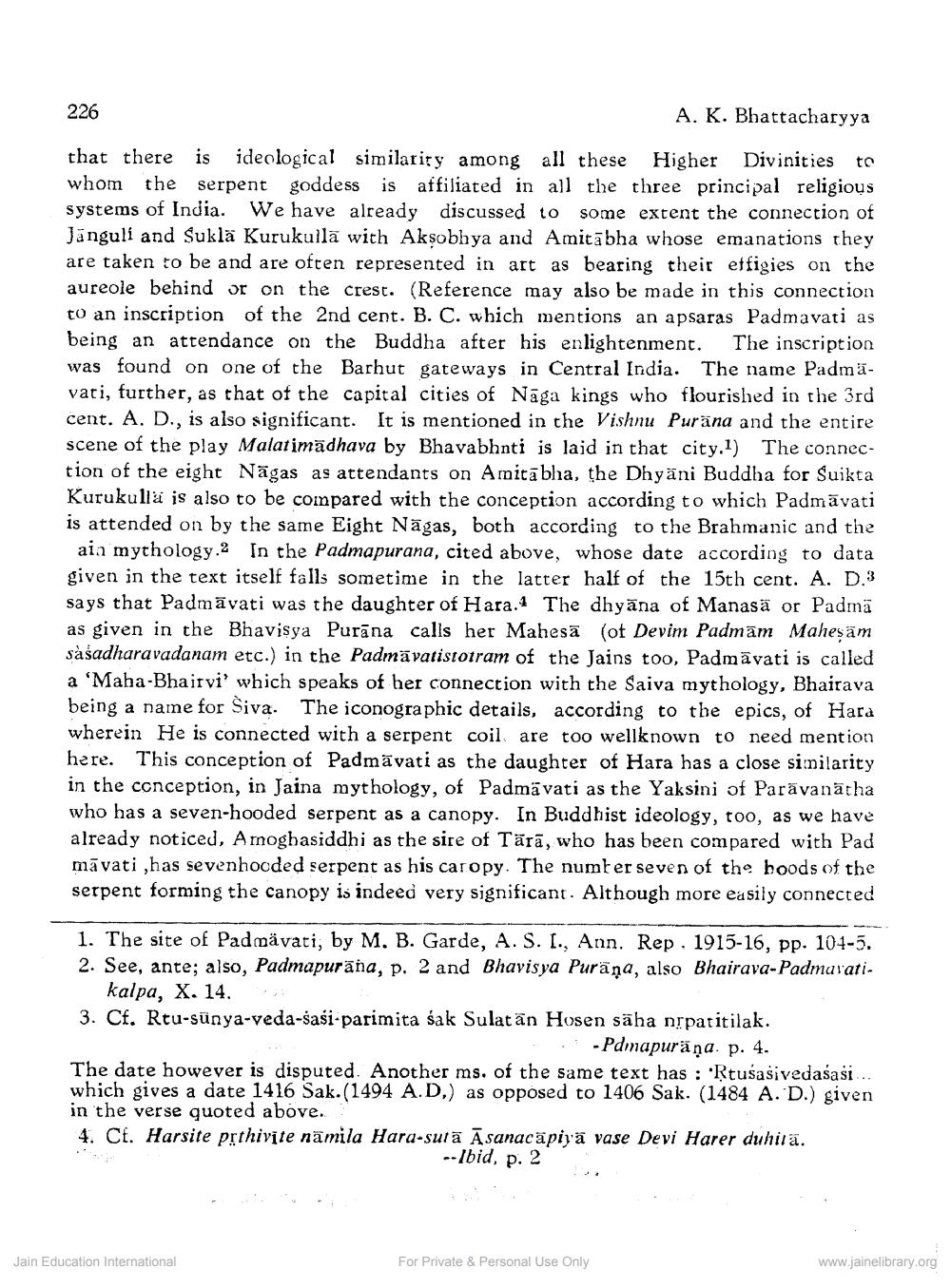Book Title: Introduction to Iconography of Jain Goddess Padmavati Author(s): A K Bhattacharya Publisher: Z_Jinvijay_Muni_Abhinandan_Granth_012033.pdf View full book textPage 8
________________ 226 A. K. Bhattacharyya that there is ideological similarity among all these Higher Divinities to whom the serpent goddess is affiliated in all the three principal religious systems of India. We have already discussed to some extent the connection of Jänguli and Sukla Kurukulla with Aksobhya and Amitabha whose emanations they are taken to be and are often represented in art as bearing their effigies on the aureole behind or on the crest. (Reference may also be made in this connection to an inscription of the 2nd cent. B. C. which mentions an apsaras Padmavati as being an attendance on the Buddha after his enlightenment. The inscription was found on one of the Barhut gateways in Central India. The name Padmävati, further, as that of the capital cities of Nāga kings who flourished in the 3rd cent. A. D., is also significant. It is mentioned in the Vishnu Purana and the entire scene of the play Malatimadhava by Bhavabhnti is laid in that city.1) The connection of the eight Nāgas as attendants on Amitābha, the Dhyāni Buddha for Suikta Kurukullä is also to be compared with the conception according to which Padmāvati is attended on by the same Eight Nāgas, both according to the Brahmanic and the aia mythology.2 In the Padmapurana, cited above, whose date according to data given in the text itself falls sometime in the latter half of the 15th cent. A. D.3 says that Padmavati was the daughter of Hara.1 The dhyana of Manasä or Padma as given in the Bhavisya Purana calls her Mahesā (of Devim Padmām Mahesām såśadharavadanam etc.) in the Padmavatistotram of the Jains too, Padmavati is called a 'Maha-Bhairvi' which speaks of her connection with the Saiva mythology, Bhairava being a name for Siva. The iconographic details, according to the epics, of Hara wherein He is connected with a serpent coil are too wellknown to need mention here. This conception of Padmavati as the daughter of Hara has a close sinilarity in the conception, in Jaina mythology, of Padmavati as the Yaksini of Parāvanātha who has a seven-hooded serpent as a canopy. In Buddhist ideology, too, as we have already noticed, Amoghasiddhi as the sire of Tārā, who has been compared with Pad māvati ,has sevenhooded serpent as his caropy. The number seven of the hoods of the serpent forming the canopy is indeed very significant. Although more easily connected 1. The site of Padmavati, by M. B. Garde, A. S. I., Ann. Rep. 1915-16, pp. 104-5. 2. See, ante; also, Padmapuräna, p. 2 and Bhavisya Purana, also Bhairava-Padmavati. kalpa, X. 14. 3. Ct. Rtu-sünya-veda-sasi-parimita sak Sulat än Hosen säha nrpatitilak. - Pdmapuräņa. p. 4. The date however is disputed. Another ms. of the same text has : Rtusasivedasasi .. which gives a date 1416 Sak.(1494 AD) as opposed to 1406 Sak. (1484 A. D.) given in the verse quoted above. 4. Ct. Harsite prthivite nämila Hara-sulā Āsanacäpiyä vase Devi Harer duhilä. --Ibid, p. 2 Jain Education International For Private & Personal Use Only www.jainelibrary.orgPage Navigation
1 ... 6 7 8 9 10 11
